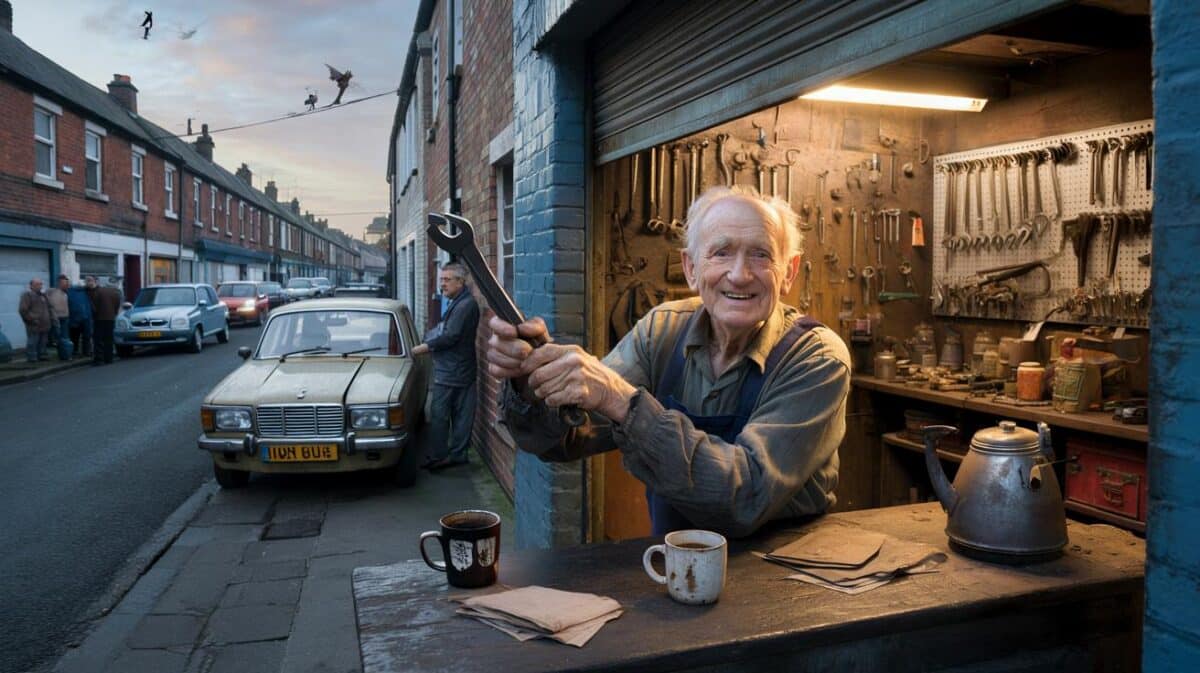What do you do when the workbench goes quiet and the clock, for once, stops pushing you along? A retired craftsman with seventy years on the tools says the real trick isn’t in sitting still, nor in chasing youth. It’s in building small, honest rhythms that make the day feel useful and kind. Not grand plans. Not a bucket list. Just a way to keep the hands, the heart and the mind ticking in the same gentle beat.
His bench was a map of tiny jobs: a chipped picture frame, a cracked drawer, a fishing stool leg rescued from someone’s loft. He moved with the easy certainty of someone who has measured a thousand cuts and still trusts the pencil over the rule. We talked as the light crept up the street and the village woke. It starts with a pencil. His secret isn’t what you think.
A life built with hands, not hurry
Eric started at fourteen, sweeping shavings from floors that never seemed to stay clean for more than a minute. He laughs now, saying the broom taught him nearly as much as the chisel. Retirement didn’t feel like a curtain drop so much as a change in tempo, like switching from hammer to mallet. The work kept its shape, just softened at the edges.
He tells me about a neighbour who brought him a wobbly dining chair last winter, apologising for the bother. The fix took twenty minutes and turned into tea and a long, quiet chat about her late husband. “The thing you repair is rarely the only thing that needs mending,” he said, sliding a new dowel home with a coaxing twist. We’ve all had that moment when a small job becomes a doorway to something bigger.
There’s a practical reason this pace feels good. Small, useful tasks create clean edges for the brain, a start and a finish you can hold in your palm. Your body moves without strain, your mind gets a problem to chew, your day gains a point around which other moments gather. Purpose doesn’t need a salary or a punch clock. It just needs something that would be worse off if you didn’t touch it today.
The quiet method that keeps him young
Eric calls it the Quarter-Hour Loop. Three blocks, fifteen minutes each, repeated once before lunch and once after: move, make, meet. Move is a slow sweep of the floor, stretch the shoulders, walk to the post box. Make is one **small useful thing**: sharpen three pencils, sand a frame corner, oil the hinge that squeaks. Meet is a nudge to a person: a phone call, a doorstep hello, a text that simply says “You about?”
People overcomplicate this and burn out by Thursday. They plan full-room renovations or buy gadgets that promise a new back and better balance. The loop is quiet on purpose, more rhythm than rule, and it forgives missed days. Let’s be honest: nobody does that every single day. Eric shrugs and calls a skipped loop “weather”. He starts again when the sky clears, even if that’s just in his head.
He keeps one more principle tucked under the bench: **leave tomorrow a hook**. He never finishes everything. One screw is laid aside, one pencil line waits for the saw. It pulls him back without a fight.
“You don’t need big plans, love. You need a reason to put your boots on and a little job that notices when you’re there.”
- Quarter-Hour Loop: move, make, meet — twice a day, most days.
- Keep a visible “hook” for tomorrow: one tiny task paused at 80%.
- Aim for human contact daily, even if it’s just a wave over the fence.
What stays when the bench goes quiet
Eric says the craft is less about wood than it is about attention. He’ll sand the edge of a breadboard as if the Queen were coming for toast, not out of fuss, but out of care. That attention spills into how he listens, how he walks the lane, how he greets a stray cat by name and waits for it to decide. The work teaches softness without letting you go slack.
There’s a kind of joy in being the person people call when something sticks, rattles or sags. It keeps you threaded into the fabric of the place you live, like a quiet stitch you can only see from behind. Eric’s trick for staying active and happy isn’t a hack. It’s the gentle stubbornness of showing up for little things until they turn into a good day. He calls it **move, make, meet**, and smiles when I write it down.
It’s not a manifesto. It’s a bench, a pencil, and a phone that rings just enough. He doesn’t chase youth or try to outrun time. He looks for the next hinge that wants oil and the next person who needs a hand with a stubborn jar. The secret travels well, even if you’ve never held a chisel. Build a loop that suits your hands. Leave yourself one neat hook for tomorrow. Let a useful day do the rest.
| Key points | Detail | Interest for the reader |
|---|---|---|
| The Quarter-Hour Loop | Three 15-minute blocks: move, make, meet, repeated twice most days | A simple, repeatable routine that boosts energy without overwhelm |
| Leave tomorrow a hook | End tasks at about 80% so you want to return | Reduces friction and keeps momentum effortlessly |
| Purpose over projects | One useful action daily beats grand plans | Practical, doable, and mood-lifting for any age |
FAQ :
- What if I’m not “handy” at all?Pick tasks that match your world: stitch a loose button, re-pot a plant, sort a drawer, draft a kind email. The method is about rhythm and purpose, not carpentry.
- How long should the loop take each day?About ninety minutes in total if you run it twice, with breaks as you like. Some days it’s one pass. On busy days, a single fifteen-minute block still counts.
- Isn’t this just staying busy?Busy is noise. This is focus. Each block has a why: move for body, make for mind, meet for connection. Busy fills time; this fills you.
- What if health limits my movement?Shrink the tasks, not the intention. Chair stretches, gentle handwork, voice notes to a friend. The loop bends to you and still gives shape to the day.
- How do I start if I feel flat?Begin with the smallest visible thing. Sharpen one pencil. Wipe one handle. Send one text. Momentum often hides in the first five minutes.









